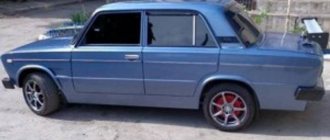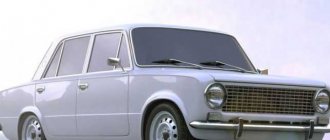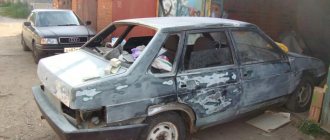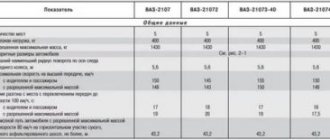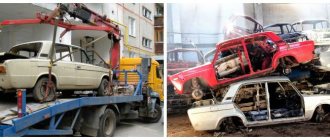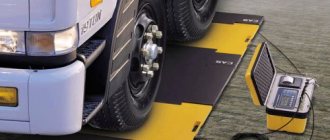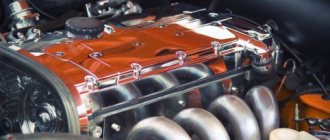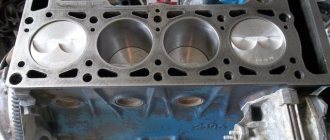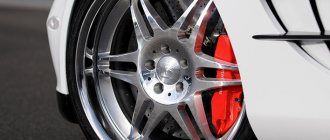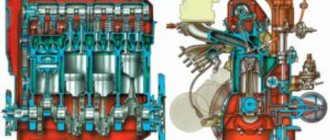The most common vehicles in the post-Soviet space have always been considered to be the products of the Volga automobile industry. These cars faithfully served their owners for decades. Therefore, the question of how much a VAZ 2107 weighs for scrap metal does not surprise anyone. The same applies to other car models that are subject to recycling.
The Lada Seven, according to documents, has a mass of 1049 kg. However, its weight is practically no different from any other brand of car from the Volzhsky Automobile Plant. The average weight of this Soviet car, which is often scrapped, is around one ton.
Sometimes owners of relatively new cars have to go to a metal collection point. The vehicle may be damaged as a result of an accident or other accident. In some situations, from an economic point of view, the only right decision would be to scrap the car.
Sometimes drivers prefer to disassemble the car themselves. Therefore, the relevance of the question of how much a VAZ 2101 body weighs for scrap metal is understandable. Considering that Kopeyka is the oldest representative of this line of the domestic automobile industry, it is the leader among cars that can be recycled. Its scrap weight is 955 kg, of which the body takes up about 280.
Features of car recycling
Before you scrap your car, you should familiarize yourself with the principles of this procedure. The average weight of a vehicle is 1000 kg. If the entire car can be recycled, the collection point will deduct 30% for clogging. The latter includes all non-metallic elements, pollution, etc.
Let's consider how much a car for scrap metal weighs using the example of a VAZ 2105. The weight of the latter is 955 kg. Thus, taking away the blockage, we get about 660 kg. You should also take into account the price of scrap, which differs depending on the city. As a rule, in megacities, the number of rubles received for a car will significantly exceed the amount earned in a similar organization in a small locality.
Before calculating the profit from a scrapped car, you need to take into account transportation costs. If the car is a pile of metal, you need to take care of a tow truck. If there are spinning wheels and functional steering, the car can be transported in tow. Then, this expense item will not be so significant. Therefore, in order to calculate how much a Zhiguli costs when scrapped, it is not enough to know how much a VAZ 2109 or 21099 weighs for scrap metal (915 kg). It is necessary to take into account the features of recycling and the requirements of collection points. It would be useful to know the average cost of scrap metal in the region. Additional awareness will allow you to avoid fraud on the part of unscrupulous receivers.
Despite the fact that disassembling a car is a labor-intensive procedure, many owners still decide to take this step. Thus, you can sort ferrous and non-ferrous metals and hand them over separately, removing the good parts. From an economic point of view, the procedure will be justified.
Let's consider how much a VAZ 2106 weighs for scrap metal based on individual significant structural elements:
It should be noted that dismantling machine parts requires a lot of time and certain skills. In the absence of the latter, it would be more rational to recycle it entirely.
How much does the VAZ 2106 body weigh and what are its dimensions? People often ask on forums and car portals. Indeed, interest in the most popular car in the post-Soviet space was and remains incredibly high. Find out more by reading useful information on the body of this car. A lot depends on how much the body of the VAZ 2106 weighs, including the condition of the main parameters of the car.
How much does a VAZ (Zhiguli, Lada, Niva) car weigh?
Home > a >
| VAZ-2101 | 955 | 1355 |
| VAZ-2102 | 1010 | 1440 |
| VAZ-2103 | 955 | 1355 |
| VAZ-2104 | 1020 | 1475 |
| VAZ-2105 | 995 | 1395 |
| VAZ-2106 | 1045 | 1445 |
| VAZ-2107 | 1030 | 1430 |
| VAZ-2108 | 900 | 1325 |
| VAZ-2109 | 945 | 1370 |
| VAZ-21099 | 970 | 1395 |
| VAZ-21011 | 955 | 1355 |
| VAZ-2110 | 1010 | 1485 |
| VAZ-21102 | 1020 | 1495 |
| VAZ-21103 | 1040 | 1515 |
| VAZ-2111 | 1040 | 1540 |
| VAZ-21111 | 1030 | 1530 |
| VAZ-21113 | 1060 | 1560 |
| VAZ-2112 | 1040 | 1515 |
| VAZ-21122 | 1020 | 1495 |
| VAZ-2113 | 975 | 1400 |
| VAZ-2114 | 970 | 1395 |
| VAZ-2115 | 985 | 1410 |
| VAZ-2121 | 1210 | 1610 |
| VAZ-2170 Lada Priora | 1088 | 1578 |
| VAZ-2170 Lada Priora station wagon | 1088 | 1593 |
| VAZ-1118 Lada Kalina | 1070 | 1545 |
The curb weight of a vehicle is the weight of a vehicle with standard equipment, various consumables (oil, coolant, etc.), but minus the weight of passengers, driver and luggage.
Dry weight is equal to curb weight, but only without fuel, some equipment and consumables. That is, this is the mass of an unloaded vehicle without fuel.
The permissible gross weight is the weight of the maximum loaded vehicle provided by the manufacturer. This is sometimes called the maximum permissible mass. It is better not to go beyond the limits of this indicator, unless, of course, you want your car to last for a very long time. The increased load has a negative impact on the car body and suspension parts.
wikimassa.org
Body weight
Let’s say right away that the “six” weighs exactly 1045 kg. Its mass is decomposed as follows:
- The weight of the power unit together with additional equipment is 140 kg;
- The gearbox weighs about 26 kg;
- Shaft – 10 kg;
- Rear axle – 52 kg;
- Radiator – 7 kg;
- Body – 280 kg.
It turns out that the body is the heaviest part of the car. It is exactly twice as heavy as the engine. The remaining parts of the machine have approximately the same mass.
Body dimensions of the “six” and their verification
There is a concept of car body size. Along with this, it is customary to talk about geometric dimensions, which imply control standards and distances, the geometry of door and window openings, the distance between axes and much more.
As a rule, a car that has been in an accident is checked for displacement of the main body elements. Particular attention is paid to the following body parts:
- Diagonals. The car is driven onto the overpass, and then the distance from one extreme point of the floor to the other is checked diagonally using a tape measure. If there is a discrepancy between the distances on one side and the other, there is movement of the body;
- Racks. They are subject to mandatory verification. First of all, if the car has been in an accident, the whole side, not damaged, is diagnosed, and only then the damaged side.
Note. As for the choice of body points, in this case you can choose any. For example, you can select from the pillar to the extreme point of the rear door.
- Roof. To make sure that the roof is not leaking, you need to measure the dimensions of the doorways diagonally. The dimensions, of course, must match on both sides;
- Glass. The conformity of the windshield and rear windows is checked. Both are measured diagonally.
Standard linear/geometric dimensions of the VAZ 2106 body
| Dimensions of front/rear door openings diagonally, mm | 1273/983 (plus/minus 2 mm) |
| Distance between the posts (from the centers of the upper hinge links to the opposite pillars of the openings in the center of the door lock latches) front/rear, mm | 889/819 (plus/minus 2 mm) |
| Distance between central pillars without upholstery (measured at 270 mm from the bottom of the opening), mm | 1397 (plus/minus 2 mm) |
| Dimensions of window openings (wind/rear), mm | 1375/1322 (plus/minus 4 mm) |
| Diagonal dimensions for the hood opening, mm | 1594 (plus/minus 3 mm) |
| Diagonal dimensions for trunk lid, mm | 1446 (plus/minus 4 mm) |
Main characteristics of the “six”
VAZ 2106 is considered a Soviet and Russian car, produced in the period 1975-2005. The car was manufactured and produced at VAZ, but already in 1998 some production facilities were moved to Syzran and Kherson. In 2002, the “six” was assembled at IzhAvto, where the last model of the legendary car was left on the assembly line.
It will be interesting to know: in total, over 4,300 million VAZ 2106 units have been produced in the entire history of the automotive industry at various factories.
The “Six” was also produced in several modifications. Regarding the body, the following noteworthy points can be made:
- The modification of the VAZ 21061, intended for sale in Canada, had a completely different body installed. This one had special aluminum bumpers and fangs. The bumper also had trims and ends made of black plastic;
- The VAZ 21063 body was equipped with “five” bumpers;
- The body of 21065 was also equipped with aluminum bumpers, and some of the cars going for export were generally modified;
- The VAZ 2121 was equipped with a body with the same bumpers as on the export 21061, only without sidelights.
As for specialized modifications:
- The “six” was produced in a pickup truck. It was a modification of the "Tourist". The pickup truck had a tent built into the bed;
- A single copy of the “six” called “half past six” was produced by order of Leonid Ilyich. It was equipped with a different hood, modified for this modification.
Note. An interesting fact: according to the norms of Soviet industrial economics, the “six” with its dry weight of 1045 kg fell into the group of small class cars, but in terms of the volume of the power unit it fell into the third group.
The body of the “six” and its mass played an important role in compiling the technical data of the car.
Vehicle specifications
| Vehicle weight (fully equipped), kg | 1045 |
| Payload, kg | 400 |
| Permissible maximum weight, kg | 1445 |
| Ground clearance (front/rear), mm | 175/170 |
| Permissible weight of cargo in the luggage compartment, kg | 50 |
| Maksim. speed (with permissible total cargo weight - 150 kg, with a driver and one passenger), km/h | 152 |
| Acceleration time to 100 km/h (with a permissible total cargo weight of 150 kg, with a driver and one passenger), s | 17,2 |
| Acceleration time to 100 km/h (with driver and one passenger), s | 16 |
| Fuel consumption per 100 km at speeds: 90-120 km/h highway/city, l | 10,1/10,3 |
| Stopping distance with the highest permissible weight during sudden braking (80 km/h), m | 36 |
Performance indicators
| Maximum speed | 150 km/h |
| Acceleration time (0-100 km/h) | 17.5 s |
| Fuel consumption in the city per 100 km | 10.1 l |
| Fuel consumption on the highway per 100 km | 7.4 l |
| Combined fuel consumption per 100 km | 10.1 l |
| Fuel tank volume | 39 l |
| Vehicle curb weight | 1035 kg |
| Permissible gross weight | 1435 kg |
| Tire size | 175/70 SR13 |
Dependence of acceleration parameters on mass
Engineers and designers know that there are a couple of classic methods to help improve vehicle data. And weight, or rather its ratio, plays almost the most important role in this matter.
Purely hypothetically: if you reduce the weight of the “six” by 10 percent, then the acceleration time to hundred (as we remember, it was 16 seconds) will also decrease by 10 percent. And this is already 15 seconds, which, you agree, is a good result.
To be specific, such a linear relationship between weight and acceleration only works in airless space, that is, in space. In fact, the car does not increase its parameters after 130 km/h, since it is impossible not to take into account the ASV (aerodynamic impact). And no matter how you reduce the weight of the car, you won’t help the matter. She will devote a lot to overcoming resistance. For example, if the power is 80 hp, then 40 hp. will definitely go to resistance, and the other half to acceleration.
It turns out that on cars with more power, weight reduction will have a more positive effect. The power unit still has a lot of power left for acceleration.
Another interesting point concerns the following. During maximum acceleration, the rear axle of the “six” is loaded. A portion of the weight moves from the front to the rear. For a rear-wheel drive car, this is only for the better - road traction becomes more effective. For the same reason, if we are talking about reducing weight on the “six”, it is recommended not to touch the rear, but to localize efforts to unload the middle and front zones.
Note. Another advantage in this regard can be considered the transfer of some components from the hood to the luggage compartment. For example, it could be a battery, washer reservoir, etc.
A few tips to ease the “six”
In order to make the VAZ 2106 a little lighter, it is recommended to do the following:
- Operate the vehicle with an incomplete fuel tank. As you know, a tank filled to the brim means an extra 80 kg of weight, which will certainly affect acceleration and fuel consumption.
- Some experienced drivers also keep the washer reservoir empty - an extra 4-15 kg of weight.
- Carrying a spare tire with you is, of course, correct. But without a spare wheel, the car loses about 12-25 kg, and this is no longer trivial.
- A lot also depends on the type of disk. Thus, it is recommended to use forged wheels. They reduce not only the total, but also the inertial mass by 10-20 kg.
- It is advisable to install the lightest battery. So, a 70-amp battery weighs 5 kg more than a 55-amp battery. We draw the appropriate conclusions.
More tips regarding more bodywork:
- Welding the frame will not only increase the rigidity characteristics of the body, but also significantly reduce the weight. The fact is that in this case an unnecessary, extra piece of metal is cut out of the body (no longer needed to maintain rigidity). In addition, it will be possible to install lightweight doors;
- You can replace standard heavy glasses with polycarbonate ones. This will reduce the weight of the car by 30-50 kg;
- You can install bumpers made of lightweight materials instead of standard ones. It will also be necessary to remove standard fasteners and clamps, which will ultimately result in a weight reduction of 20-70 kg;
- The hood and trunk can be replaced with similar ones, but made of composite materials;
- The audio systems in the car, including speakers and a huge subwoofer, also affect the mass;
- You can replace the seats with sports ones;
- Muffler tuning, carried out correctly, results in a weight reduction of up to 40 kg;
- Lightening the power unit by replacing cast iron manifolds;
- Installing a light flywheel results in a reduction of 3-8 kg;
- Standard suspension elements can be replaced with tuning ones, aluminum levers can be installed;
- Replace the steering wheel and gear shift knob.
Remember that the weight of the VAZ 2106 body affects not only the acceleration of the car, but also its other important parameters. Reducing weight affects good handling, braking and much more.
The instructions for lightening the weight of a car given above are not the only one of its kind. Every driver acquires valuable knowledge over time and uses it. In general, competent tuning of a car can be done with your own hands, if you know the nuances and technical data of a particular car model. Videos and photos will greatly help in this matter.
Forget about fines from cameras! An absolutely legal new product - Traffic Police Camera Jammer, hides your license plates from the cameras that are installed in all cities. More details at the link.
- Absolutely legal (Article 12.2);
- Hides from photo and video recording;
- Suitable for all cars;
- Works through the cigarette lighter connector;
- Does not cause interference to radios and cell phones.
For most modifications of the VAZ 2106 sedan, the body weight varies from 1035 kg to 1050 kg.
Model body weight:
Weight of bodies of popular modifications:
- VAZ 2106 2106 1.6 MT (1976 – 2006): 1035 kg.
- VAZ 2106 21063 1.3 MT (1976 – 1993): 1035 kg.
- VAZ 2106 21061 1.5 MT (1976 – 2006): 1035 kg.
- VAZ 2106 21065 1.6 MT (1976 – 2006): 1050 kg.
Model body features:
The base and roof of the VAZ 2106 body are made in the form of solid stamped trough-shaped panels. The side of the body consists of an inner panel (strut reinforcements) and an outer panel (three pillars, threshold, rear fender).
Important: the body design of the VAZ 2106 provides for the possibility of making a right-hand drive model on its basis (export version).
Other names:
The 4-door sedan VAZ 2106 was also produced under the names VAZ 1600 and Lada 1600.
Years of production Years of production: 1976-2006.
| Total body weight of VAZ 2106 | |||
| General view General view of bodies | Bare body weight min (kg) Minimum body weight for different modifications of VAZ 2106 | ||
Data are presented in kilograms (kg)
Data are presented in kilograms (kg)
| Bare body weight max (kg) Maximum vehicle weight for different modifications | Modifications Number of modifications of the model in our database | ||
| (General form) | 250 (kg) | 330 (kg) | 3 |
| Body weight VAZ 2106 | |
| Parameter Vehicle Parameter | |
Caution: the data presented separately for the body are indicative, and may differ from the real ones by 15% in one direction or the other.
VAZ-2106 is a true classic of the Soviet automotive industry. The car was produced for a long time after the collapse of the Union, which is explained by its incredible reliability. In addition, it stands out from other domestically produced cars due to its amazing maintainability of literally every component, availability of spare parts, and unlimited possibilities for modernization.
An important advantage of the VAZ-2106 is the engine used in this car. This four-stroke unit, equipped until 2002 with a carburetor and then with an injection fuel ignition system, can run on even the lowest quality gasoline, rarely fails in extreme cold, and can be operated successfully in almost any conditions. Any of its problems are eliminated even without the participation of a specialist - any more or less experienced car enthusiast can easily cope with routine repairs.
Useful information about the "seven"
VAZ 2107 body length
The weight of the “seven” is exactly 1030 kilograms. At the same time, the car body is the heaviest among all other parts and components (600 kg). Its assembly diagram differs in a standard, classic sequence for VAZs and includes the following elements:
- Front end parts along with fenders, complemented by reinforcements;
- Roof;
- The bottom is also well reinforced, especially in the front and rear;
- Sidewalls.
Each of the parts is made from a special type of steel, has its own ID number, a specific mold and casting pattern. So, the roof of the “seven” always has a thickness of 0.9 mm.
The body parts are combined with each other by welding. If elements, for example, such as the floor, bear a significant load, they are additionally strengthened by arc welding.
In addition to the main elements, the body of the “seven” also has attached parts called “tails”. These are the parts that can be connected with bolts and hinges to the main frame - bumpers, hood, and so on.
Regardless of the configuration, the VAZ 2107 has certain dimensions.
The body length of the VAZ 2107 reaches 4126 mm, the width is 1620 mm, and the height is 1435 mm.
Control dimensions or correct body geometry
It is not enough for the owner of the “Seven” to know only the standard parameters of the car. It will also be useful to study the control body dimensions of the VAZ 2107 or the points of the car’s frame, especially if the owner plans to improve the dynamics of the car by lightening the body.
The diagram below shows the main control dimensions of the VAZ 2107.
Body dimensions geometry VAZ 2107
| Basic, standard line | |
| 1, 2, 3 | Upper mounting of radiator, crankcase, steering gear and clutch/brake pedal shaft |
| 4 | Steering center |
| 5 | Rear wheel center |
| 6, 7 | Rear suspension shock absorber mounting and rear muffler mounting |
| 8 | Front muffler mounting |
| 9 | Rear suspension cross rod attachment |
| 10 | Rear wheel axle |
| 11, 12 | Fastening the upper and lower longitudinal rods of the rear suspension |
| 13 | Front wheel center |
| 14, 15 | Front suspension cross member mounting points and anti-roll bar mounting |
| 16 | Lower radiator mount |
| 17 | Car axle |
| 18 | Upper radiator mount |
| 19 | Rear motor mount |
| 20 | Fastening the propeller shaft support |
| 21 | Rear suspension shock absorber mounting |
The same diagram shows how to check the control points of the body floor.
Control dimensions of the body of the VAZ 2107 floor
| Reference line | |
| 1 | Intersection of the axes of the front anti-roll bar mounting bolts with the surfaces of the side members |
| 2 | Center of the axes of the lower bolts securing the steering gear housing and the pendulum arm bracket |
| 3 | Intersection of the centers of the front technological holes of the front floor with the surfaces of the side members |
| 4 | The intersection of the rear technological holes of the front floor side members with the surfaces of the side members |
| 5, 6 | Center of the axes of the bolts for fastening the lower and upper longitudinal rods |
| 7 | Intersection of the axis of the transverse rod mounting bolt with the body bracket |
| 8 | Intersection of the center of the rear technological hole of the central reinforcement of the rear floor with the surface of the amplifier |
| 9 | Center of the front stabilizer bar mounting bolts |
| 10 | The intersection of the centers of the axes of the lower mounting bolts of the steering gear housing and the pendulum arm bracket with the surfaces of the side member splash guards |
| 11, 12 | Centers of the front and rear technological holes of the front floor side members |
| 13 | The intersection of the axes of the bolts securing the lower longitudinal rods with the outer surfaces of the body brackets |
| 14 | The intersection of the axes of the bolts for fastening the upper longitudinal rods with the outer surfaces of the middle side members |
| 15 | Intersection of the axis of the transverse rod mounting bolt with the body bracket |
| 16 | Center of the rear technological hole of the central reinforcement of the rear floor |
| 17 | Longitudinal axis of the car |
Control of the geometry of the body and the attachment points of the chassis and floor units is carried out on a special installation. This is a special type of machine designed for body inspection and repair. This is what he looks like.
VAZ 2107 body control dimensions and their correction
On such a machine, not only measurements are carried out, but also further editing of the body. The purpose of the operation is to recreate the original linear dimensions of the body.
ID VAZ 2107
On the “seven”, like other cars, individual technical information is indicated. It is presented in the table, which can be found under the hood.
IDs imply information not only about the car model. This contains detailed information about the body number and its weight.
VAZ-2106 engine weight
On a VAZ-2106 car, the weight of the engine without gearbox is 121 kilograms. Therefore, it is strictly not recommended to try to remove or move this unit alone - this is a direct path to serious injury. It is best to hire an assistant who can help you during the process of dismantling or installing the motor.
With all the necessary equipment, including both the cylinder head and the ignition system, the engine weight will be even greater - 140 kilograms.
Finally, when assembled with the gearbox and the devices attached to it, this value will increase by another 26 kilograms.
As you can see, weight can be considered a significant disadvantage of the car compared to imported analogues. To reduce it, increase power, and also improve dynamic characteristics, many drivers today install parts made of light metal alloys.
In 1984, a diesel version of the “six” was released at a Bulgarian automobile company. Replacing a gasoline engine with a diesel engine didn't have much of an impact on the car's performance. Firstly, the Bulgarians failed to increase the power of the power unit. Secondly, its weight increased by about 10 kilograms, which can also be called a disadvantage of the alteration.
Why does the engine get hot?
The most common defect of the 2106 engine is its overheating. The engine operating temperature is just before +96°C.
The reasons that the engine began to get very hot may be malfunctions of the following systems and components:
- thermostat, air lock;
- radiator, its clogging;
- low quality of liquid used for cooling;
- the fan has failed.
If engine overheating is detected, you must immediately stop the car and carry out a thorough examination and eliminate the cause. If the engine begins to heat up due to a broken thermostat, then this device must be replaced with a new one.
Other characteristics of the VAZ-2106 engine
The weight of the motor is, although important, but far from its main characteristic. That is why we decided to talk about other features of the power unit installed on various modifications of the “six”. For example, engine power on carburetor models was 77 horsepower. After switching to an injector, it dropped to 75 hp. With. However, this parameter can always be increased by carrying out a number of upgrades.
The cylinder diameter of the VAZ-2106 power unit is 79 millimeters, the torque can reach 3000 rpm, and the working volume is 1568 cubic centimeters. Finally, the compression ratio of the engine is 8.5 atmospheres, and the piston stroke is 80 millimeters.
What is the compression of this engine?
VAZ-2106 is a true classic of the Soviet automotive industry. The car was produced for a long time after the collapse of the Union, which is explained by its incredible reliability. In addition, it stands out from other domestically produced cars due to its amazing maintainability of literally every component, availability of spare parts, and unlimited possibilities for modernization.
An important advantage of the VAZ-2106 is the engine used in this car. This four-stroke unit, equipped until 2002 with a carburetor and then with an injection fuel ignition system, can run on even the lowest quality gasoline, rarely fails in extreme cold, and can be operated successfully in almost any conditions. Any of its problems are eliminated even without the participation of a specialist - any more or less experienced car enthusiast can easily cope with routine repairs.
On a VAZ-2106 car, the weight of the engine without gearbox is 121 kilograms. Therefore, it is strictly not recommended to try to remove or move this unit alone - this is a direct path to serious injury. It is best to hire an assistant who can help you during the process of dismantling or installing the motor.
Finally, when assembled with the gearbox and the devices attached to it, this value will increase by another 26 kilograms.
As you can see, weight can be considered a significant disadvantage of the car compared to imported analogues. To reduce it, increase power, and also improve dynamic characteristics, many drivers today install parts made of light metal alloys.
In 1984, a diesel version of the “six” was released at a Bulgarian automobile company. Replacing a gasoline engine with a diesel engine didn't have much of an impact on the car's performance. Firstly, the Bulgarians failed to increase the power of the power unit. Secondly, its weight increased by about 10 kilograms, which can also be called a disadvantage of the alteration.
The weight of the motor is, although important, but far from its main characteristic. That is why we decided to talk about other features of the power unit installed on various modifications of the “six”. For example, engine power on carburetor models was 77 horsepower. After switching to an injector, it dropped to 75 hp. With. However, this parameter can always be increased by carrying out a number of upgrades.
The cylinder diameter of the VAZ-2106 power unit is 79 millimeters, the torque can reach 3000 rpm, and the working volume is 1568 cubic centimeters. Finally, the compression ratio of the engine is 8.5 atmospheres, and the piston stroke is 80 millimeters.
knock on any door song
The engine of the VAZ-2106 car is a modification of the power unit from the Troika. It is quite possible that this is why its design retained a number of weak points of its predecessors. Domestic craftsmen have learned to diagnose engine problems almost by sound. As an example, we will give several symptoms of breakdowns, and also tell you which engine elements could fail:
In addition, quite often VAZ-2106 owners encounter the following carburetor and ignition system malfunctions:
All these malfunctions, with experience, can be eliminated in no time - you just need to remove the damaged unit, disassemble it and, accordingly, replace the worn parts.
The VAZ 2106 engine is a unique development for its time by the VAZ automobile plant. In 1976, this unit could rightfully be considered one of the most advanced solutions on the market. Designed for passenger cars, this engine easily met the needs of car enthusiasts of the late Soviet era.
This is a classic engine with a closed cooling system. There is a special container for coolant, which is located on the top of the camshaft.
The engine performs its duty cycle in four strokes. It works on the basis of a carburetor system. To ensure that the container inside the unit cools quickly, there is a special system for forced circulation of coolant.
Combined lubrication system. This means that the process is based on both pressure and spray.
This unit is very successful compared to its predecessors. Its development was based on then modern technical solutions. The engineers were faced with a difficult task - it was necessary to significantly improve the existing engine models of the VAZ plant.
The best solution is to leave the one you have. However, some craftsmen install other units. You need to remember that the hood of this car is small in size. Therefore, VAZ 2106 engines with a cylinder diameter of 79 ml will feel most comfortable. You cannot install units that are too powerful, since neither the brake system, nor the axle, nor the suspension will be able to service them. It is recommended to install the following models:
In any case, it will be necessary to make some modifications related to the design features of each model.
Weaknesses of the VAZ-2106 engine
The engine of the VAZ-2106 car is a modification of the power unit from the Troika. It is quite possible that this is why its design retained a number of weak points of its predecessors. Domestic craftsmen have learned to diagnose engine problems almost by sound. As an example, we will give several symptoms of breakdowns, and also tell you which engine elements could fail:
- The appearance of loud knocking noises at idle clearly indicates the need to adjust the valves. Under normal operating conditions, this problem usually occurs no more often than once every 7-10 thousand kilometers;
- The occurrence of metal-on-metal knocking indicates that the connecting rod bearings or piston pins are worn out. Both faults must be corrected immediately to prevent serious damage to the power unit;
- the so-called ceramic knock may indicate that the pistons of the VAZ-2106 have failed. You can still get to a car service center with such a breakdown, but it’s definitely not recommended to travel around the city and beyond;
- extraneous sounds in the lower part of the engine, which are accompanied by a sharp drop in the oil level - this is a clear sign of problems with the main bearings. In this situation, it is better to immediately use the services of a tow truck, since an independent trip even a short distance is fraught with major troubles.
In addition, quite often VAZ-2106 owners encounter the following carburetor and ignition system malfunctions:
- insufficient or, on the contrary, excessive fuel enrichment;
- throttle problems;
- failure of a high-voltage wire;
- moisture entering the ignition coil insulator;
- spark plug wear.
All these malfunctions, with experience, can be eliminated in no time - you just need to remove the damaged unit, disassemble it and, accordingly, replace the worn parts.
| Value Parameter value in (kg) | |
| 01.3 l., Petrol, Mechanical, 4 speed, rear | |
| Curb weight: | 1035 (kg) |
| Bare weight: | 250-300 (kg) |
| Permissible gross weight: | 1435 (kg) |
| Load capacity: | 400 (kg) |
| 1.5 l., Petrol, Mechanical, 5 speed, rear | |
| Curb weight: | 1035 (kg) |
| Bare weight: | 250-300 (kg) |
| Permissible gross weight: | 1435 (kg) |
| Load capacity: | 400 (kg) |
| 1.6 l., Petrol, Mechanical, 4 speed, rear | |
| Curb weight: | 1050 (kg) |
| Bare weight: | 275-330 (kg) |
| Permissible gross weight: | 1435 (kg) |
Other
VAZ 2106 2106 1.6 MT is a 4-door car with a 4-speed gearbox. With the number of seats for the driver and passengers: 5. The maximum permissible speed is 150 km/h. Acceleration time to 100 km/h is 17.5 s. Average fuel consumption per 100 km is: in the urban cycle - 10.1 liters, on the highway - 7.4 liters, in the combined cycle - 10.1 liters. Maximum fuel tank volume is 39 l. A full tank is enough for approximately: 386 km when driving around the city, 527 km when driving on the highway, 386 km when driving the combined cycle. The maximum load capacity of the vehicle is 400 kg.
- Fuel consumption VAZ 2106
- Maximum speed of VAZ 2106
- Dimensions and dimensions of the VAZ 2106
- Acceleration to 100 km/h VAZ 2106
This is interesting: Where is the VIN code of the car in the documents?
